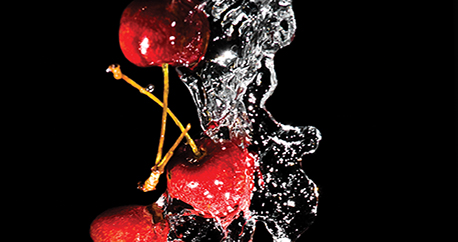Fortunately for the Beaver State’s growers, many trees damaged by freezing temperatures in 2014 came back in 2015.
“We lost some trees, maybe 10 to 15 percent of trees in The Dalles,” confirms Bailey. But the outlook for 2016’s crop is positive. “The trees are responding, and we expect an 80 to 90 percent crop (at Orchard View Farms) this year,” he says. In anticipation of the harvest, Orchard View is installing a new Unitech packing line with optical sorting equipment—48 lanes—the world’s largest to date, according to Bailey.
Far North Finish: Washington
Cherries are Washington’s fifth most valuable crop behind apples, wheat, hay, and potatoes. The sweet cherry harvest occurs in three areas, east of the Cascade Mountains: the Yakima Valley, Wenatchee (North Central), and the Columbia Basin.
Lower elevations, in the Yakima and Columbia regions, bloom and mature earlier. Higher elevations, like those around Wenatchee and the top of the Yakima Valley, bloom later.
FACTS & FIGURES
California, Oregon, and Washington produce more than 90 percent of U.S. sweet cherries, reaching 320,000 tons in 2015 according to the U.S. Department of Agriculture (USDA). Sweet cherries from Oregon (41,000 tons in 2015) and Washington (210,000 tons) are the Northwest’s second most valuable fruit, after apples. California’s sweet cherry crop, about 68,000 tons in 2015, rivals the value of the state’s other tree fruits, like nectarines and peaches.Michigan, Montana, and Idaho ship some fresh sweet cherries as well, but Michigan tops the chart for tart cherries, primarily used for baking and processing. Traverse City, MI also claims to be the “Cherry Capital of the World” and hosts the National Cherry Festival each year, a weeklong celebration held in July.
Although average annual per capita consumption of sweet cherries peaked in 2006 at about 1.6 pounds per person, more recent figures from the USDA’s Economic Research Service find consumption down a bit, but fluctuating between 1.0 and 1.5 pounds each year.
The 2015 Washington cherry season was full of surprises. “It was one of the earliest bloom dates in industry history,” says Columbia Marketing’s Lutz. “We shipped cherries before the end of May, earlier than normal.”
Washington cherry shipments usually start in June and end in August. Chelan is the earliest major variety, followed by Tieton; Rainier and Bing harvests begin in mid-June, with Bings then extending
to early August. Late-season cherries in Washington mature a week or more after Bing: Lapin, which is rapidly replacing the late-season Lambert, is first, followed by Skeena. The final cherry to be harvested is the Sweetheart.
Craig Campbell, chief executive officer at CDS Distributing, Inc., says the early cherry bloom wasn’t the only surprise last year. “We were done shipping cherries by the third week of July,” he explains. As a producer of late-season Sweetheart cherries on 30 acres in the Yakima Valley near Tieton at an elevation of 2,000 feet, he says, “I don’t ever recall a season this early.”
Ron Everts of Borton & Sons, Inc. in Yakima says this year’s winter had ample snow but no below-zero or single-digit temperatures in the company’s growing areas through late February. In turn, there weren’t worries about bud and tree damage like last year. Borton & Sons also had high hopes for a few early midseason varieties, or those that ripen before Bings.
“We have some younger cherry orchards growing Benton, Cristalina, and Coral Champagne cherries,” notes Eric Borton, vice president of international sales and marketing. The company expects these varieties to produce both “higher yields and better quality in the coming seasons,” he says.
Washington is also the leading organic cherry grower, with 1,400 acres on 80 different farms, producing more than 8,000 tons according to a 2014 USDA survey. Organic or conventional, however, labor availability remains the state’s biggest hurdle, especially as volume climbs with new higher-density orchards. “Trellised orchards are very productive,” Campbell says, noting most of the newer plantings are early varieties.



